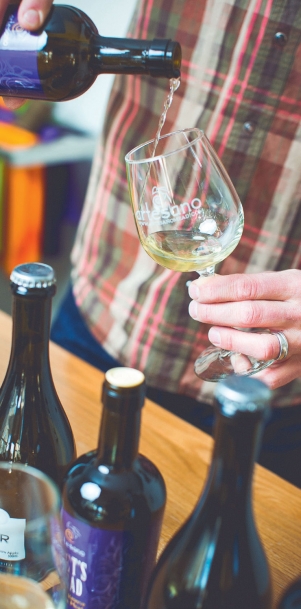From Hive To Bottle: Artesano Meadery
Mark Simakaski is spending these next few months fermenting a dilution of honey in order to make mead, an Old World beverage. Mark is the owner and brewer at Artesano Meadery in Groton, Vermont, and his passion began with the bees.
During his time in the Peace Corps, Mark learned a great deal about beekeeping. Afterwards, he and his wife spent some time in Argentina thinking about what to do with themselves after their return home. It was during this time that they came up with the Spanish-influenced name “Artesano,” which Mark explains is sort of a new word for “arts-man, or craftsman.” 1995 saw the beginning of his beekeeping hobby here in Vermont and today he shares some of his insight on the culture of mead: “Honey has always been an expensive source of sugar, so mead has always been a drink for festive occasions. It’s very old and very traditional but I make it with modern winemaking equipment, which really helps develop its flavor from hive to bottle.”
The ingredients are simple. The key to mead is the source of honey. Unlike pressing grapes for wine or mashing malted grains for beer, honey is already a sugar—it’s ready to go. When the honey flows, so do the flavors of the land, Vermont’s terroir, adding a specific taste of place. The flavors and aromas in mead come from the flowers from which the honeybees forage nectar.
About 1,500,000 flowers are visited by honeybees for every bottle of mead. Colonies of bees collect and partially digest their bounty into what we know as honey. The honey is drained from the comb and then mixed with water and yeast. Yeasts digest the sugars and produce alcohol, and afterwards mead is drawn off into bottles or aged for some time.
Mead is the oldest fermented beverage, with traces leading back to Asian pottery vessels from around 7000 BC. Some experts claim that thousands of years ago, honey and water would mix after a rain, naturally ferment in the trunks of old hollow trees along with the beehive, and indigenous peoples would find and collect the fermenting liquid.
Mead recipes of earlier cultures relied on the spontaneous fermentation of honey mixed with water. A jug of this mixture would sit in the open air and wild yeasts would find their way into the liquid, consume the sugar, multiply and produce the alcoholic brew. Though the actual levels of alcohol in prehistoric meads are nearly impossible to discern, meads today often run between 8% and 12% by volume.
As an alcoholic drink, mead has a long, rich history, found woven into the myths and folklore of many cultures. It was a traditional beverage of the Vikings, Saxons, Celts, Egyptians, Greeks and Romans among others. Ancient Greeks referred to the brew as ambrosia or nectar and it was often saved for royalty in the Middle Ages.
Modern traditions still carry the influence of ancient mead culture. For example, Scandinavians brought us the term “honeymoon” to refer to the festivities following a wedding. Mead would be consumed for one full cycle of the moon after tying the knot because it was thought to be a drink of fertility. A full month of drinking!
The festivity of mead lives on through Artesano. Each bottle of mead that Mark produces links us with the oldest of cultures and a stream of tradition that still survives to this day. The delicate floral aromas from Vermont’s spring and summer are captured in each bottle. Right now, the mead that will pour for 2015 is being fermented and aged. Additions of local ingredients are found in different meads ranging from raspberry and blueberry to chili-cinnamon and spiced. And while mead can be made traditional or sparkling, 2015 will also bring about an exciting new addition worth celebrating: a port-style mead.
Discover what the bees have spent a great part of the year gathering. Experience the taste and floral aromas of Vermont. Mark Simakaski, with the help of hundreds of thousands of local bees, brings us the world’s oldest fermented beverage.
To read more visit ArtesanoMead.com







